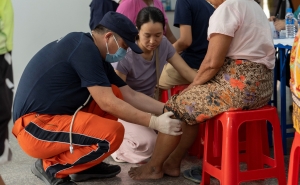When Mosquitoes Are Biting During Rainy Season, Net Use Increases, Study Finds
New research suggests malaria prevention efforts need to account for reduced use of bed nets during the dry season, when perceived risk drops
The more rainfall a region in sub-Saharan Africa gets, the more mosquitoes proliferate there and the more likely its residents will sleep under their insecticide-treated bed nets to prevent malaria transmission, a new study from the Johns Hopkins Center for Communication Programs suggests. CCP is based at the Johns Hopkins Bloomberg School of Public Health.
While it has become clear in recent years that net use is higher in the rainy season than in the dry season, the results, published this month in the American Journal of Tropical Medicine and Hygiene, are the first to quantify this phenomenon. This new data will allow malaria control programs to see what times of year net use is lagging and use the information to intensify behavior change messages to boost net use before malaria transmission peaks, even if it doesn’t seem like the mosquitoes are biting yet.
“What we are seeing by studying rainfall patterns is that in places with year-round rainfall, which means year-round malaria transmission, people who have bed nets are using them all year, which is great news,” says CCP’s Hannah Koenker, PhD, MPH, who led the study.
In countries with a dry season, the new data show that net use peaks six to eight weeks after rains begin, which corresponds with the time it takes mosquitoes to breed and build up their populations. Malaria transmission can happen before then, however. “By better understanding seasonal patterns of net use, we can make more informed decisions about how to most effectively deploy nets and when it makes sense to heavily promote their use,” she says.
To conduct the research, Koenker and her colleagues brought together data from multiple years of net use surveys from countries across sub-Saharan Africa, and assessed monthly net use using large datasets of precipitation, temperature, demographics and malaria incidence to better understand when and where people use their nets throughout the year.
Koenker says the findings make it clear that those who study and promote net use must consider the time of year that these assessments take place. If a survey is done in the rainy season and the next is conducted in the dry season, it may appear that net use has dramatically fallen off, when it is in fact part of the normal seasonal cycle of net use. Likewise, she says, increases in net use from survey to survey could be skewed if the second survey is simply conducted when it is rainier.
“We all need to take the season into account when interpreting data around net use,” Koenker says.
In addition, she says, “it is critical to use social and behavior change interventions that encourage people who have nets to use them during times when transmission is just starting, and when the rains stop but transmission is still happening. This may mean that some programs may need to redirect behavior change efforts toward the dry season, and work to convince people that it is worthwhile to use their nets even when mosquito abundance and perceived risk may be quite low.”
The World Health Organization estimates that between 2000 and 2015 the rate of new malaria cases declined by 37 percent globally and malaria deaths fell by 60 percent, with 6.2 million lives saved. Three quarters of those gains can be attributed to interventions such as insecticide-treated bed nets.
“Quantifying Seasonal Variation in Insecticide-Treated Net Use among Those with Access” was written by Hannah Koenker, Cameron Taylor, Clara Burgert, Julie Thwing, Tom Fish and Albert Kilian.
This work was funded through the United States Agency for International Development (USAID) and the President’s Malaria Initiative (PMI) under the terms of USAID/JHU Cooperative Agreement No. AID-OAA-A-14-00057 (VectorWorks Project).
# # #
Media contacts: Stephanie Desmon at 410-659-6156 or sdesmon1@jhu.edu and Barbara Benham at 410-614-6029 or bbenham1@jhu.edu.





